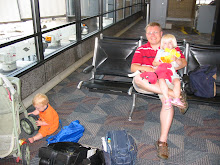This first picture is the battlefield before fighting began. The Germans are on the right, USA on the left...

Here we see things after they have started a bit... The two Kingtigers have been damaged as a result of direct and indirect fire. But now the Panthers (Panzer V's) are in position to move through the gap...

And they make it through, although severely damaged... Still, things are looking good for the Germans. They have destroyed and damaged more tanks than the Americans, relatively speaking. (the Panzer III's took a beating, and a Panzer IV or two was KO'ed. But for the most part, the German warmachine is still intact.)

Here's where I stopped the battle, primarily because it was getting late and I wanted to make this post... I think the game has some tactical depth, and just the right amount of complexity. Tell me what you think when you read the rules...

By the way, just a note... Me playing this game by myself meant that I was able to finish it in about 30 minutes, maybe 45 at most. It would probably take an hour and a half to play this between two opponents. That's not too bad, when you think that other miniature games take lots more time. As I said, tell me what you think. Thanks!
 Here we see things after they have started a bit... The two Kingtigers have been damaged as a result of direct and indirect fire. But now the Panthers (Panzer V's) are in position to move through the gap...
Here we see things after they have started a bit... The two Kingtigers have been damaged as a result of direct and indirect fire. But now the Panthers (Panzer V's) are in position to move through the gap...  And they make it through, although severely damaged... Still, things are looking good for the Germans. They have destroyed and damaged more tanks than the Americans, relatively speaking. (the Panzer III's took a beating, and a Panzer IV or two was KO'ed. But for the most part, the German warmachine is still intact.)
And they make it through, although severely damaged... Still, things are looking good for the Germans. They have destroyed and damaged more tanks than the Americans, relatively speaking. (the Panzer III's took a beating, and a Panzer IV or two was KO'ed. But for the most part, the German warmachine is still intact.) Here's where I stopped the battle, primarily because it was getting late and I wanted to make this post... I think the game has some tactical depth, and just the right amount of complexity. Tell me what you think when you read the rules...
Here's where I stopped the battle, primarily because it was getting late and I wanted to make this post... I think the game has some tactical depth, and just the right amount of complexity. Tell me what you think when you read the rules...  By the way, just a note... Me playing this game by myself meant that I was able to finish it in about 30 minutes, maybe 45 at most. It would probably take an hour and a half to play this between two opponents. That's not too bad, when you think that other miniature games take lots more time. As I said, tell me what you think. Thanks!
By the way, just a note... Me playing this game by myself meant that I was able to finish it in about 30 minutes, maybe 45 at most. It would probably take an hour and a half to play this between two opponents. That's not too bad, when you think that other miniature games take lots more time. As I said, tell me what you think. Thanks!


